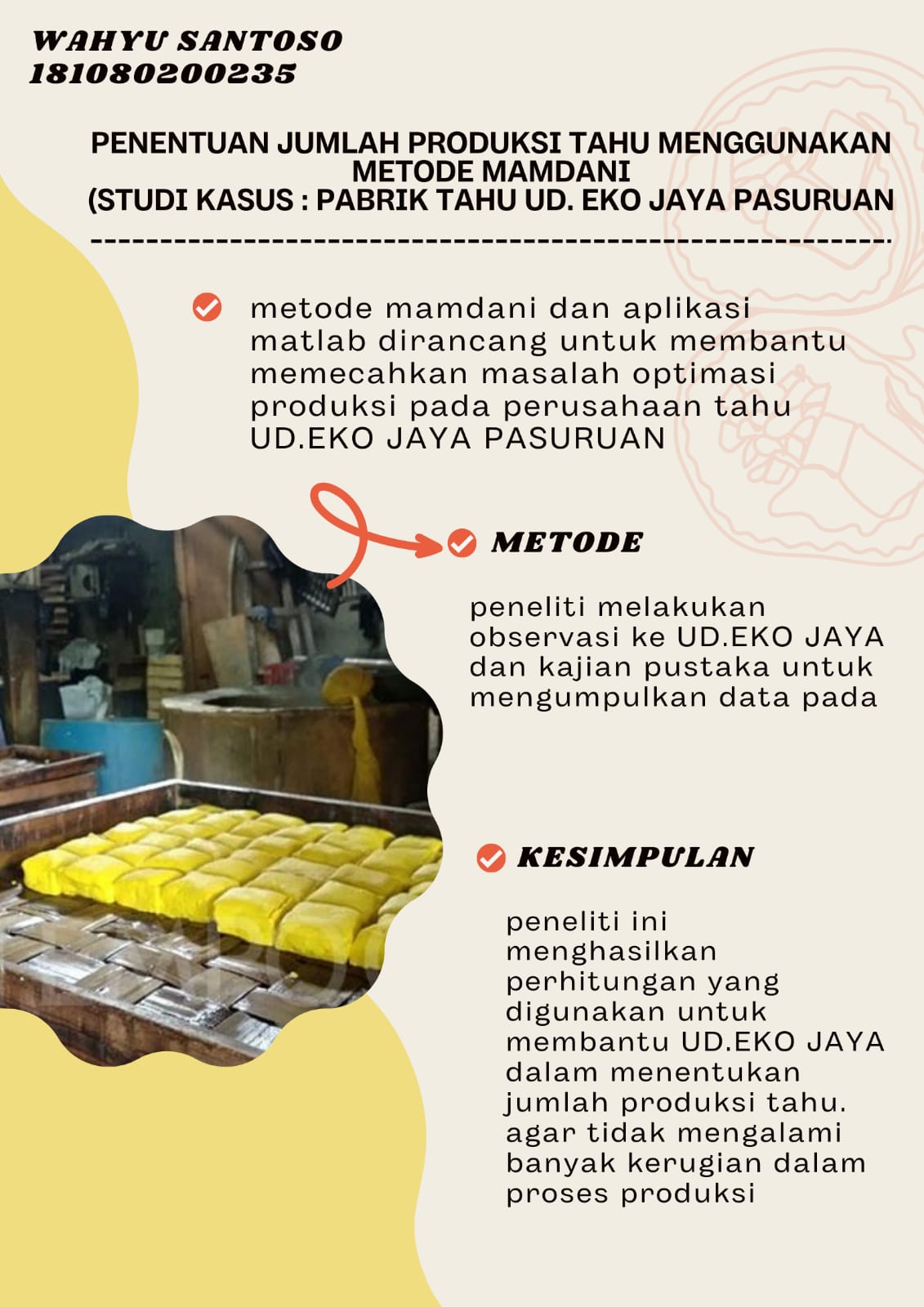Determining the Production Amount of Tofu Using Mamdani Method (Case Study: UD. Eko Jaya Pasuruan Tahu Factory)
Penentuan Jumlah Produksi Tahu Menggunakan Metode Mamdani (Studi Kasus: Pabrik Tahu UD. Eko Jaya Pasuruan)
DOI:
https://doi.org/10.21070/pels.v2i2.1285Keywords:
Fuzzy Logic, Mamdani, Production AmountAbstract
Lots of problems that contain uncertainty arise in this world. Fuzzy logic is one of the methods created to analyze systems that contain these uncertainties. In this study, the author uses the Mamdani method or often also known as the Min-Max method which is an application of the fuzzy method. The purpose of this study was to determine the amount of tofu production at UD. Eko Jaya Pasuruan by using the MinMax (Mamdani) method. The data used is the number of requests and the amount of product inventory at UD. Eko Jaya in June 2022. After that, data analysis was carried out using the Mamdani fuzzy method to determine the amount of production. The design of the system to obtain the output is carried out in several stages, including (a) forming fuzzy sets, (b) application of implication functions, (c) forming rules, and (d) affirmation (defuzzification). In this study, defuzzification was carried out using the centroid method. From the results of data processing that has been carried out, using input variables in June 2022, namely the number of requests of 14,000 pcs and the amount of inventory of 3000 kg each producing an output of 13,808 pcs.
Downloads
References
Kusumadewi. “Aplikasi Logika Fuzzy Untuk Pendukung Keputusan”. Yogyakarta: Graha Ilmu. 2004
F.Susilo. “Himpunan Dan Logika Kabur Serta Aplikasinya”. Yogyakarta: Graha Ilmu. 2006.
S. Basriati, “Penerapan Metode Fuzzy Sugeno Untuk Menentukan Jumlah Produksi Optimum (Studi Kasus : PT. Jordan Bakery Pekanbaru),” Seminar Nasional Teknologi Informasi Komunikasi dan Industri, no. 0, pp. 471–477, Nov. 2019.
T. Temucin, “Multi-Criteria Decision Making: A Cast Light Upon the Usage in Military Decision Process,” Research Anthology on Military and Defense Applications, Utilization, Education, and Ethics, 2021.
A. Mulyanto, “Penerapan Metode Fuzzy Tsukamoto Untuk Menentukan Jumlah Jam Overtime Pada Produksi Barang Di PT Asahi Best Base Indonesia(ABBI) Bekasi,” Jurnal Informatika SIMANTIK, vol. 1, no. 1, pp. 1–11, Sep. 2016.
P. Gultom, M. Zarlis, and Z. Situmorang, “Model Fungsi Keanggotaan Fuzzy Multi Criteria Decision Making Padap Program Sertifikasi Guru,” Magister Thesis, Universitas Sumatera Utara, 2013.
N. Noviardi and D. Dilson, “Internet of Things Untuk Mitigasi Bencana Tanah Longsor Studi kasus : Jalan lintas Sumbar Riau,” Prosiding SISFOTEK, vol. 2, no. 1, pp. 68–73, Sep. 2018.
R. Rosita, A. Hudoyo, and A. Soelaiman, “ANALISIS USAHA, NILAI TAMBAH, DAN KESEMPATAN KERJA AGROINDUSTRI TAHU DI BANDAR LAMPUNG,” Jurnal Ilmu Ilmu Agribisnis: Journal of Agribusiness Science, vol. 7, no. 2, pp. 211–218, Jul. 2020, doi: 10.23960/jiia.v7i2.3383.
A. G. Salman, “PEMODELAN SISTEM FUZZY DENGAN MENGGUNAKAN MATLAB,” ComTech, vol. 1, no. 2, pp. 276–288, 2010.
A. Tjolleng, Pengantar Pemrograman MATLAB: Panduan praktis belajar MATLAB. Jakarta: Elex Media Komputindo, 2017.




